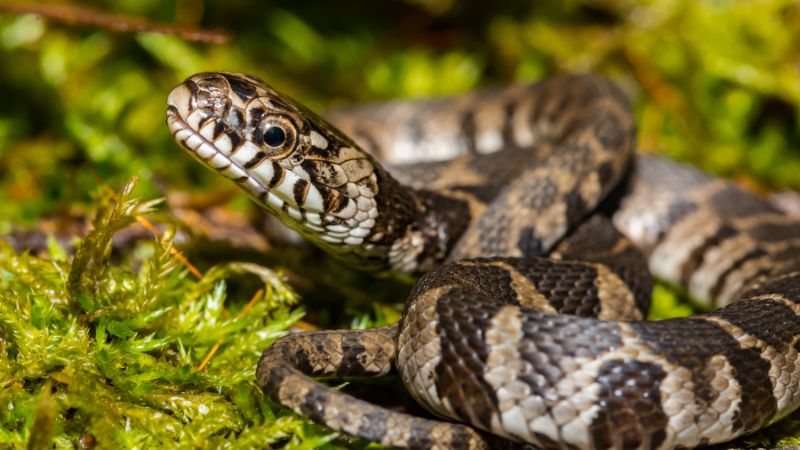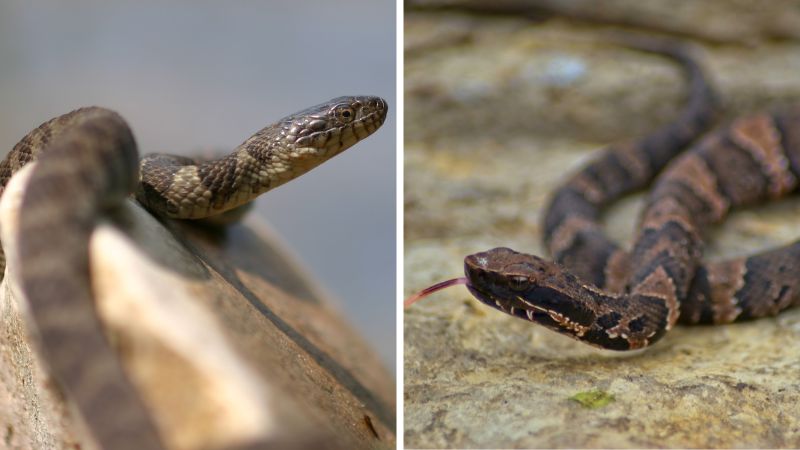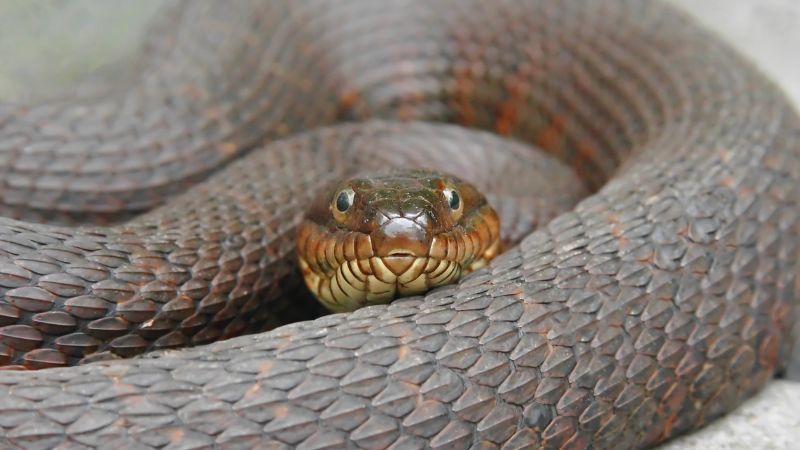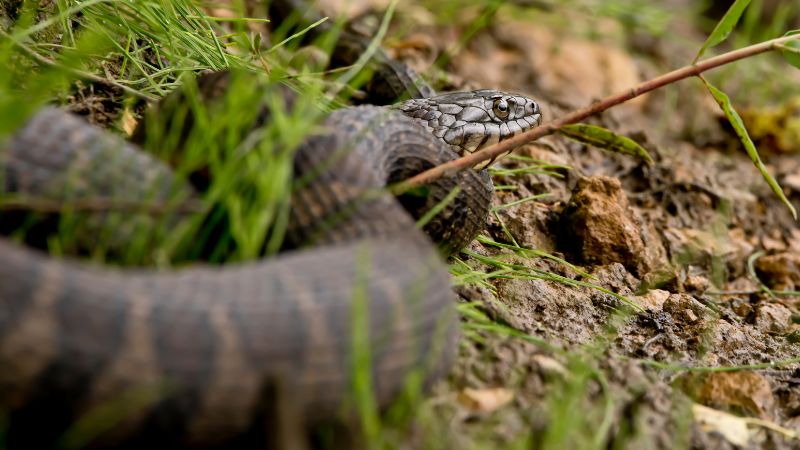Although the Northern water snake is nonvenomous and only bite when they feel threatened, they are still quite aggressive. Additionally, their bites can cause bacterial infections that warrant medical attention. This is why getting rid of them should be a top priority.
So, how to get rid of Northern water snakes? You can do so by sweeping them into a large enough container, using glue boards, placing damp and dry burlap bags, or installing baited funnel traps.
By reading this article, you get to know how to properly identify Northern water snakes, how to catch them and get rid of them, and how to ultimately prevent them from coming back. Scroll for more!
What Are Northern Water Snakes?

Northern water snakes (Nerodia sipedon) are dark snakes with square blotches and/or bands forming across their backs and sides. They have keeled scales and may come in tan, brown, or gray in color.
Technically, Northern water snakes are a subspecies of the common watersnake. They are native and found across Central and Eastern North America. Moreover, they are considered invasive species in areas where they were introduced in.
What Do Northern Water Snakes Like?
Northern water snakes love being in or near water as they are well-adapted aquatic reptiles. However, they still bask on floating logs, rocks, or branches to gather warmth into its body during cold days.
What Do Northern Water Snakes Eat?
They eat a wide range of prey, including fish, amphibians, large insects, crayfish, other snakes, leeches, turtles, small mammals, and birds. Northern water snakes are scavengers that hunt both in the day and at night.
Where Do Northern Water Snakes Live?
Northern water snakes inhabit ponds, rivers, sloughs, streams, lakes, impoundments, bogs, and marshes. They also go onto land but never too far away from their aquatic habitats.
How Long Does Northern Water Snakes Live?
Northern water snakes live up to 9 years in captivity, but that depends on environmental conditions and whether or not they are given the proper care and maintenance. Meanwhile, their longevity in the wild is unknown.
How Big Will Northern Water Snakes Get?
Adult snakes grow to lengths of 24 to 55 inches and weigh between 81 to 560 grams. Females are typically bigger than the males as this species exhibits sexual dimorphism.
What Is the Behavior of Northern Water Snakes?
Northern water snakes are typically solitary creatures except during the fall and spring when they can be found basking together in groups after overwintering. Although they are more active during the day, they can still be spotted at night.
Related: How to Get Rid of Corn Snakes? | What Makes Them Aggressive?
What’s the Difference Between a Northern Water Snake and Cottonmouth?

Northern water snakes are usually mistaken for Cottonmouth snakes due to their seemingly similar appearance and the fact that they inhabit the same habitats. Here are some key differences to tell them apart:
| Characteristics | Northern Water Snake | Cottonmouth Snake |
| Body | Slender body with a long, thin tail | Thick and heavy body with a short, thick tail |
| Head and neck | Narrow head with a neck that’s the same width as the head | Triangular, blocky head with a narrow neck |
| Pupils | Round-shaped | Elliptical-shaped |
Related: How to Get Rid of Cottonmouth Snakes? | Effective Techniques and Safety Tips
Are Northern Water Snakes Venomous?
No, Northern water snakes don’t have venom. However, their saliva still consists of bacteria that may cause infection to a bitten host and would require medical attention nonetheless.
Is It Safe to Catch & Remove Water Snakes?
It depends on the species, specifically if the water snake is venomous or not. For example, Cottonmouth snakes are a venomous water snake species and should therefore not be caught, removed, and relocated by yourself.
On the other hand, Northern water snakes are relatively harmless but may bite when necessary. Although it is possible to catch and remove the snake, it should be done with utmost precaution and while wearing protective gear.
Related: How to Get Rid of Garter Snakes | Effective Techniques for a Snake-Free Home
How Dangerous Are Northern Water Snakes?

Northern water snakes are an aggressive species and will resort to biting when they are mishandled or when they feel threatened. However, their more common reaction to threats are hiding underwater.
Why Are Northern Water Snakes Attracted to Your House?
If you live near a Northern water snake habitat, it’s possible that the snakes are attracted to your house because they seek food, potential nesting sites, or shelter either from harsh weather conditions or from predators.
Signs of Northern Water Snakes
If you see one or a combination of these signs, you may have a Northern water snake infestation in your property:
- Shed snake skin
- Slither tracks or winding trails
- Fecal droppings
- Hissing noises or strange noises coming from interiors
- Musky scent
- Actual sighting of the snakes themselves
Related: How to Identify Snake Droppings? | Identification and Guide
How Do I Catch a Northern Water Snake?
If you’ve encountered a Northern water snake outdoors, it’s best to simply leave it alone as it will go away on its own. However, if you must remove them, do so by spraying them with a water hose from a safe distance.
On the other hand, if you find one inside your house, safely remove it by sweeping it into a trash can or waste basket big enough to fit the snake. Release the snake somewhere far from the property.
How to Get Rid of Northern Water Snake?

As mentioned earlier, one of the most efficient ways of getting rid of Northern water snakes is to place them into a large enough container. You can either sweep them inside using a broom or using tongs, sticks, poles, and other long items.
Here are other ways you can get rid of these snakes:
- Glue boards: Attach 3 to 4 glue boards to plywood or simply staple them together. Place them along the foundation of your house or along interiors. Once caught, pour vegetable oil on the board to release the snake.
- Burlap bags: Place a damp burlap bag in a dark, cool place then cover it with a dry bag. This attracts the snake as it serves as a temporary habitat. Once the snake is caught, remove both the bags and the snake using a shovel.
- Traps: Install a funnel trap and bait it to lure in and capture Northern water snakes. You can increase the effectiveness of this method by attaching a drift fence to the trap. This helps guide the snakes inside the trap.
Related: How to Get Rid of Rattlesnakes | Effective and Safe Methods
How to Prevent Northern Water Snake From Getting Into Your House?
The most effective way of preventing these snakes from coming back into your home and property is by exclusion. Here are some following tips you can follow:
- Check for any gaps and openings that are larger than a quarter inch. If there are any, fill these with concrete mortar or caulk to effectively seal them and prevent snake entry.
- Install door sweeps and screens on vents and windows when necessary. The more you cover your house, the less likely they are to enter them a second time.
- Put up a snake-proof fence made out of solid sheeting or heavy-duty mesh. Although this is costly, it serves as an efficient barrier against snakes that want to reenter your property.
Related: How to Get Rid of Timber Rattlesnakes | Effective Methods to Ensure Safety
List of Sources
California Department of Fish and Wildlife. (n.d.). California’s Invaders: Northern Watersnake.
University of Florida Department of Wildlife Ecology & Conservation. (n.d.). Harmless Watersnake or Venomous Water Moccasin?
Gillilland, M. (n.d.). Nerodia sipedon: Northern Water Snake.
Howington, A. (n.d.). Northern Watersnake (Nerodia sipedon).
Messmer, T. A. (2018). 12 Ways to Stop Snakes From Slithering Into Your Yard.
Messmer, T. A., & Wiscomb, G. W. (2010). Non-venomous Snakes.
University of Florida Wildlife – Johnson Lab. (n.d.). Dealing With Snakes – Safely Handling Encounters.
- How to Get Rid of Turtles | Proven Long-Term Solutions! - August 26, 2023
- How to Get Rid of Kingsnakes | Easy & Humane! - August 26, 2023
- How to Get Rid of Northern Water Snakes | Best Solutions and Preventative Measures! - August 19, 2023

